Ongoing Projects
|
| |
Sensitizers for Photodynamic Therapy |
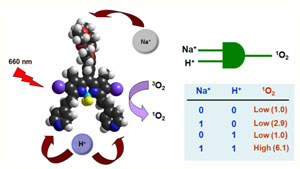 Photodynamic therapy (PDT) is a noninvasive method of treating malignant tumors and age-related macular degeneration, and is particularly promising in the treatment of multidrug-resistant (MDR) tumors. The PDT strategy is based on the preferential localization of certain photosensitizers in tumor tissues upon systemic administration. The sensitizer is then excited with red or near infrared (NIR) light, generating reactive oxygen species (ROS) including singlet oxygen (1O2) and thus irreversibly damaging tumor cells. Current practice of PDT is limited to a few functionalized porphyrins, however these compounds are not considered to be ideal drugs for use in PDT. Among the limitations, the most prominent is the low extinction coefficient of porphyrins in the body's therapeutic window (650-800 nm, low absorptivity region in typical mammalian tissues). Therefore, there is a significant impetus to develop novel and more efficient sensitizers for use in PDT. Our first contribution to the field was a water soluble perylenediimide derivative with absorption in the red end of the visible spectrum. We have recently disclosed our work in extending the conjugation in BODIPY dyes, resulting in novel dyes with strong absorptions in the red and near IR region of the spectrum. We have then reported BODIPY derivatives which are efficient generators of singlet oxygen, and studied their photocytotoxicity on human leukemia cells (K562). Within the last year, we are trying to utilize single walled carbon nanotubes as delivery agents for the PDT. In addition, our ongoing interest in molecular logic gates and photodynamic reagents apparently converged in one study, yielding the first example of a PDT agent which is at the same time a molecular AND logic gate. This molecular automaton introduces an additional layer of selectivity, generating singlet oxygen at much higher rate only if, both of the selected cancer related cellular parameters are at high levels. Photodynamic therapy (PDT) is a noninvasive method of treating malignant tumors and age-related macular degeneration, and is particularly promising in the treatment of multidrug-resistant (MDR) tumors. The PDT strategy is based on the preferential localization of certain photosensitizers in tumor tissues upon systemic administration. The sensitizer is then excited with red or near infrared (NIR) light, generating reactive oxygen species (ROS) including singlet oxygen (1O2) and thus irreversibly damaging tumor cells. Current practice of PDT is limited to a few functionalized porphyrins, however these compounds are not considered to be ideal drugs for use in PDT. Among the limitations, the most prominent is the low extinction coefficient of porphyrins in the body's therapeutic window (650-800 nm, low absorptivity region in typical mammalian tissues). Therefore, there is a significant impetus to develop novel and more efficient sensitizers for use in PDT. Our first contribution to the field was a water soluble perylenediimide derivative with absorption in the red end of the visible spectrum. We have recently disclosed our work in extending the conjugation in BODIPY dyes, resulting in novel dyes with strong absorptions in the red and near IR region of the spectrum. We have then reported BODIPY derivatives which are efficient generators of singlet oxygen, and studied their photocytotoxicity on human leukemia cells (K562). Within the last year, we are trying to utilize single walled carbon nanotubes as delivery agents for the PDT. In addition, our ongoing interest in molecular logic gates and photodynamic reagents apparently converged in one study, yielding the first example of a PDT agent which is at the same time a molecular AND logic gate. This molecular automaton introduces an additional layer of selectivity, generating singlet oxygen at much higher rate only if, both of the selected cancer related cellular parameters are at high levels.
|
|
| |
Sensitizers for Solar Cells |
Dye sensitized solar cells (DSSCs) appear to be highly promising alternatives to more expensive solar cell technologies. Considering the current maximal level of overall conversion efficiency (h) under simulated sunlight for DSSCs (11%), improvements in efficiency and durability would certainly facilitate widespread utilization of this technology.
It is clear that there are a number of factors determining the efficiency of solar cells, but the structural and physical properties of the sensitizer is clearly an important one. As a result, many laboratories around the world have active research programs in optimizing the dye component of the DSSCs. Ruthenium dyes, while holding the record for conversion efficiencies, have relatively low extinction coefficients, and they are also considered to be expensive and hard to purify. Motivated by the possibility of finding a replacement for metal-complex dyes, a number of chromophores including, coumarins, indolines, oligoenes, merocyanines, hemicyanines, oligothiophenes, squaraines, benzothiadiazoles, perylenetetracarboxylic acid derivatives and phthalocyanines have been studied, with varying degrees of success.
Boradiazaindacenes, commonly known as BODIPY dyes, are recognized as useful fluorescent labels for biomolecules for sometime. Within the last decade, there is much renewed interest in these dyes, due to the development of new avenues for derivatization and novel applications in a highly diverse field, including chemosensors, logic gates, light harvesters, energy transfer casettes and photodynamic therapy.
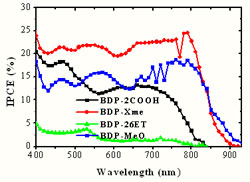 We proposed that, when judiciously designed, BODIPY dyes have certain unique features that could make them highly advantageous compared to most other organic dyes and thus, they are highly promising in this regard. i) BODIPY dyes have high extinction coefficients (70,000-80,000 M-1cm-1) and can easily be modified with any desired functionalities ii) absorption peak can be moved to longer wavelengths through simple modifications, keeping strong absorption cross-sections iii) BODIPY dyes have inherent in charge redistribution when they undergo S0->S1 transition upon excitation, increasing the charge density on the meso-carbon (C-8), while decreasing it in most other positions in the boradiazaindacene system (supporting information). This inherent directionality of charge redistribution pinpoints C-8 as the optimal position of charge injection. iv) the directionality observed in excitation can be further enhanced with strategically placed electron-withdrawing and electron donating groups, and based on the earlier work, cyanoacrylic acid and 4-N,N'-diphenylaminophenyl groups are to be of tremendous utility in this regard. We proposed that, when judiciously designed, BODIPY dyes have certain unique features that could make them highly advantageous compared to most other organic dyes and thus, they are highly promising in this regard. i) BODIPY dyes have high extinction coefficients (70,000-80,000 M-1cm-1) and can easily be modified with any desired functionalities ii) absorption peak can be moved to longer wavelengths through simple modifications, keeping strong absorption cross-sections iii) BODIPY dyes have inherent in charge redistribution when they undergo S0->S1 transition upon excitation, increasing the charge density on the meso-carbon (C-8), while decreasing it in most other positions in the boradiazaindacene system (supporting information). This inherent directionality of charge redistribution pinpoints C-8 as the optimal position of charge injection. iv) the directionality observed in excitation can be further enhanced with strategically placed electron-withdrawing and electron donating groups, and based on the earlier work, cyanoacrylic acid and 4-N,N'-diphenylaminophenyl groups are to be of tremendous utility in this regard.
Our initial results showed that especially in the red to near IR region, our BODIPY dyes displayed unprecedented efficiency. Further work is being carried out to improve the overall efficiency. |
|
Molecular Logic Gates |
 Ion-induced photophysical phenomena yield signals varying in intensity and/or color, and when viewed from a different vantage point, these changes can be correlated with the binary response of Boolean logic gates. The photoinduced electron transfer (PET) is particularly appropriate for this purpose, because the changes observed by the modulation of the thermodynamics of PET with different inputs (analytes) usually yields "off-on" type, clear digital action. For two binary variables, there are 16 different types of Boolean functions, and molecular logic gates are available for most of them. There are considerable hurdles to overcome in reaching practically useful information processing at the molecular level, such as individual addressability and higher levels of integration, further refinement of functionally integrated combinatorial circuits is essential. It would be highly desirable to have arithmetic operators which produce the same kind of output with very sharp changes in the studied parameter. Fluorescence, being an essentially zero-background technique, has clear advantages as output. The changes in the emission spectrum can also be followed at more than one wavelength, resulting in more than one logic function in a single molecular or supramolecular system. This has been first demonstrated by us (vide supra) and then recognized as a powerful tool for obtaining multiple logic expressions. Ion-induced photophysical phenomena yield signals varying in intensity and/or color, and when viewed from a different vantage point, these changes can be correlated with the binary response of Boolean logic gates. The photoinduced electron transfer (PET) is particularly appropriate for this purpose, because the changes observed by the modulation of the thermodynamics of PET with different inputs (analytes) usually yields "off-on" type, clear digital action. For two binary variables, there are 16 different types of Boolean functions, and molecular logic gates are available for most of them. There are considerable hurdles to overcome in reaching practically useful information processing at the molecular level, such as individual addressability and higher levels of integration, further refinement of functionally integrated combinatorial circuits is essential. It would be highly desirable to have arithmetic operators which produce the same kind of output with very sharp changes in the studied parameter. Fluorescence, being an essentially zero-background technique, has clear advantages as output. The changes in the emission spectrum can also be followed at more than one wavelength, resulting in more than one logic function in a single molecular or supramolecular system. This has been first demonstrated by us (vide supra) and then recognized as a powerful tool for obtaining multiple logic expressions.

|
|
Fluorescent Molecular Sensors |
|
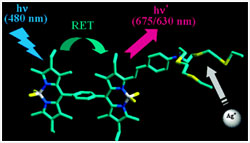 Fluorescent molecular sensor design is an active field of supramolecular chemistry, not only because of potential practical benefits in cell physiology, analytical, and environmental chemistry, but also as a proving ground for manipulation and/or engineering of various photophysical processes toward an ultimate goal of selective and sensitive signaling of targeted molecular or ionic species. Fluorescent molecular sensor design is an active field of supramolecular chemistry, not only because of potential practical benefits in cell physiology, analytical, and environmental chemistry, but also as a proving ground for manipulation and/or engineering of various photophysical processes toward an ultimate goal of selective and sensitive signaling of targeted molecular or ionic species.
Our group is primarily involved in introducing novel red emitting fluorophores to the chemosensor scene and in finding new ways of manipulating photophysical processes to obtain useful signals for effective sensing of various analytes. In 2005, we reported a novel dimeric boradiazaindacene dye which can be converted in one step to an efficient resonance energy transfer (RET) dyad. In addition, when this modification was done with appropriate ligands, RET could be coupled to ion sensing. The utility of this approach was demonstrated in a highly selective, emission-ratiometric chemosensor for Ag(I).
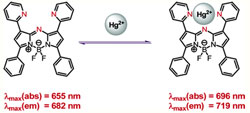 Boradiazaindacene dyads designed as energy transfer casettes were modified to signal cation concentrations ratiometrically. If the energy transfer efficiency is increased via changing spectral overlap on cation binding, an enhancement of emission signal ratios can be obtained. Larger range of ratios result in highly improved sensitivity to analyte concentrations. We demonstrated this approach in a de novo design of a novel and highly selective ratiometric chemosensor for Hg(II) ions. Boradiazaindacene dyads designed as energy transfer casettes were modified to signal cation concentrations ratiometrically. If the energy transfer efficiency is increased via changing spectral overlap on cation binding, an enhancement of emission signal ratios can be obtained. Larger range of ratios result in highly improved sensitivity to analyte concentrations. We demonstrated this approach in a de novo design of a novel and highly selective ratiometric chemosensor for Hg(II) ions.
Aryl substituted boratriaza-indacenes (Aza-Bodipy's) are a new class of dyes with long wavelength absorption and emissions. Recently, we reported the first application of these dyes in metal ion sensing. 2-Pyridyl substituents at the positions 1 and 7 create a well-defined pocket for metal ion binding. The chemosensor described in this study is remarkably selective for Hg(II) ions and both absorption and emission spectra display large changes that would allow ratiometric sensing.
|
|
|


 Photodynamic therapy (PDT) is a noninvasive method of treating malignant tumors and age-related macular degeneration, and is particularly promising in the treatment of multidrug-resistant (MDR) tumors. The PDT strategy is based on the preferential localization of certain photosensitizers in tumor tissues upon systemic administration. The sensitizer is then excited with red or near infrared (NIR) light, generating reactive oxygen species (ROS) including singlet oxygen (1O2) and thus irreversibly damaging tumor cells. Current practice of PDT is limited to a few functionalized porphyrins, however these compounds are not considered to be ideal drugs for use in PDT. Among the limitations, the most prominent is the low extinction coefficient of porphyrins in the body's therapeutic window (650-800 nm, low absorptivity region in typical mammalian tissues). Therefore, there is a significant impetus to develop novel and more efficient sensitizers for use in PDT. Our first contribution to the field was a water soluble perylenediimide derivative with absorption in the red end of the visible spectrum. We have recently disclosed our work in extending the conjugation in BODIPY dyes, resulting in novel dyes with strong absorptions in the red and near IR region of the spectrum. We have then reported BODIPY derivatives which are efficient generators of singlet oxygen, and studied their photocytotoxicity on human leukemia cells (K562). Within the last year, we are trying to utilize single walled carbon nanotubes as delivery agents for the PDT. In addition, our ongoing interest in molecular logic gates and photodynamic reagents apparently converged in one study, yielding the first example of a PDT agent which is at the same time a molecular AND logic gate. This molecular automaton introduces an additional layer of selectivity, generating singlet oxygen at much higher rate only if, both of the selected cancer related cellular parameters are at high levels.
Photodynamic therapy (PDT) is a noninvasive method of treating malignant tumors and age-related macular degeneration, and is particularly promising in the treatment of multidrug-resistant (MDR) tumors. The PDT strategy is based on the preferential localization of certain photosensitizers in tumor tissues upon systemic administration. The sensitizer is then excited with red or near infrared (NIR) light, generating reactive oxygen species (ROS) including singlet oxygen (1O2) and thus irreversibly damaging tumor cells. Current practice of PDT is limited to a few functionalized porphyrins, however these compounds are not considered to be ideal drugs for use in PDT. Among the limitations, the most prominent is the low extinction coefficient of porphyrins in the body's therapeutic window (650-800 nm, low absorptivity region in typical mammalian tissues). Therefore, there is a significant impetus to develop novel and more efficient sensitizers for use in PDT. Our first contribution to the field was a water soluble perylenediimide derivative with absorption in the red end of the visible spectrum. We have recently disclosed our work in extending the conjugation in BODIPY dyes, resulting in novel dyes with strong absorptions in the red and near IR region of the spectrum. We have then reported BODIPY derivatives which are efficient generators of singlet oxygen, and studied their photocytotoxicity on human leukemia cells (K562). Within the last year, we are trying to utilize single walled carbon nanotubes as delivery agents for the PDT. In addition, our ongoing interest in molecular logic gates and photodynamic reagents apparently converged in one study, yielding the first example of a PDT agent which is at the same time a molecular AND logic gate. This molecular automaton introduces an additional layer of selectivity, generating singlet oxygen at much higher rate only if, both of the selected cancer related cellular parameters are at high levels. 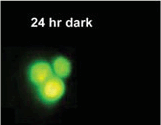
 We proposed that, when judiciously designed, BODIPY dyes have certain unique features that could make them highly advantageous compared to most other organic dyes and thus, they are highly promising in this regard. i) BODIPY dyes have high extinction coefficients (70,000-80,000 M-1cm-1) and can easily be modified with any desired functionalities ii) absorption peak can be moved to longer wavelengths through simple modifications, keeping strong absorption cross-sections iii) BODIPY dyes have inherent in charge redistribution when they undergo S0->S1 transition upon excitation, increasing the charge density on the meso-carbon (C-8), while decreasing it in most other positions in the boradiazaindacene system (supporting information). This inherent directionality of charge redistribution pinpoints C-8 as the optimal position of charge injection. iv) the directionality observed in excitation can be further enhanced with strategically placed electron-withdrawing and electron donating groups, and based on the earlier work, cyanoacrylic acid and 4-N,N'-diphenylaminophenyl groups are to be of tremendous utility in this regard.
We proposed that, when judiciously designed, BODIPY dyes have certain unique features that could make them highly advantageous compared to most other organic dyes and thus, they are highly promising in this regard. i) BODIPY dyes have high extinction coefficients (70,000-80,000 M-1cm-1) and can easily be modified with any desired functionalities ii) absorption peak can be moved to longer wavelengths through simple modifications, keeping strong absorption cross-sections iii) BODIPY dyes have inherent in charge redistribution when they undergo S0->S1 transition upon excitation, increasing the charge density on the meso-carbon (C-8), while decreasing it in most other positions in the boradiazaindacene system (supporting information). This inherent directionality of charge redistribution pinpoints C-8 as the optimal position of charge injection. iv) the directionality observed in excitation can be further enhanced with strategically placed electron-withdrawing and electron donating groups, and based on the earlier work, cyanoacrylic acid and 4-N,N'-diphenylaminophenyl groups are to be of tremendous utility in this regard.  Ion-induced photophysical phenomena yield signals varying in intensity and/or color, and when viewed from a different vantage point, these changes can be correlated with the binary response of Boolean logic gates. The photoinduced electron transfer (PET) is particularly appropriate for this purpose, because the changes observed by the modulation of the thermodynamics of PET with different inputs (analytes) usually yields "off-on" type, clear digital action. For two binary variables, there are 16 different types of Boolean functions, and molecular logic gates are available for most of them. There are considerable hurdles to overcome in reaching practically useful information processing at the molecular level, such as individual addressability and higher levels of integration, further refinement of functionally integrated combinatorial circuits is essential. It would be highly desirable to have arithmetic operators which produce the same kind of output with very sharp changes in the studied parameter. Fluorescence, being an essentially zero-background technique, has clear advantages as output. The changes in the emission spectrum can also be followed at more than one wavelength, resulting in more than one logic function in a single molecular or supramolecular system. This has been first demonstrated by us (vide supra) and then recognized as a powerful tool for obtaining multiple logic expressions.
Ion-induced photophysical phenomena yield signals varying in intensity and/or color, and when viewed from a different vantage point, these changes can be correlated with the binary response of Boolean logic gates. The photoinduced electron transfer (PET) is particularly appropriate for this purpose, because the changes observed by the modulation of the thermodynamics of PET with different inputs (analytes) usually yields "off-on" type, clear digital action. For two binary variables, there are 16 different types of Boolean functions, and molecular logic gates are available for most of them. There are considerable hurdles to overcome in reaching practically useful information processing at the molecular level, such as individual addressability and higher levels of integration, further refinement of functionally integrated combinatorial circuits is essential. It would be highly desirable to have arithmetic operators which produce the same kind of output with very sharp changes in the studied parameter. Fluorescence, being an essentially zero-background technique, has clear advantages as output. The changes in the emission spectrum can also be followed at more than one wavelength, resulting in more than one logic function in a single molecular or supramolecular system. This has been first demonstrated by us (vide supra) and then recognized as a powerful tool for obtaining multiple logic expressions. 
 Fluorescent molecular sensor design is an active field of supramolecular chemistry, not only because of potential practical benefits in cell physiology, analytical, and environmental chemistry, but also as a proving ground for manipulation and/or engineering of various photophysical processes toward an ultimate goal of selective and sensitive signaling of targeted molecular or ionic species.
Fluorescent molecular sensor design is an active field of supramolecular chemistry, not only because of potential practical benefits in cell physiology, analytical, and environmental chemistry, but also as a proving ground for manipulation and/or engineering of various photophysical processes toward an ultimate goal of selective and sensitive signaling of targeted molecular or ionic species. Boradiazaindacene dyads designed as energy transfer casettes were modified to signal cation concentrations ratiometrically. If the energy transfer efficiency is increased via changing spectral overlap on cation binding, an enhancement of emission signal ratios can be obtained. Larger range of ratios result in highly improved sensitivity to analyte concentrations. We demonstrated this approach in a de novo design of a novel and highly selective ratiometric chemosensor for Hg(II) ions.
Boradiazaindacene dyads designed as energy transfer casettes were modified to signal cation concentrations ratiometrically. If the energy transfer efficiency is increased via changing spectral overlap on cation binding, an enhancement of emission signal ratios can be obtained. Larger range of ratios result in highly improved sensitivity to analyte concentrations. We demonstrated this approach in a de novo design of a novel and highly selective ratiometric chemosensor for Hg(II) ions.